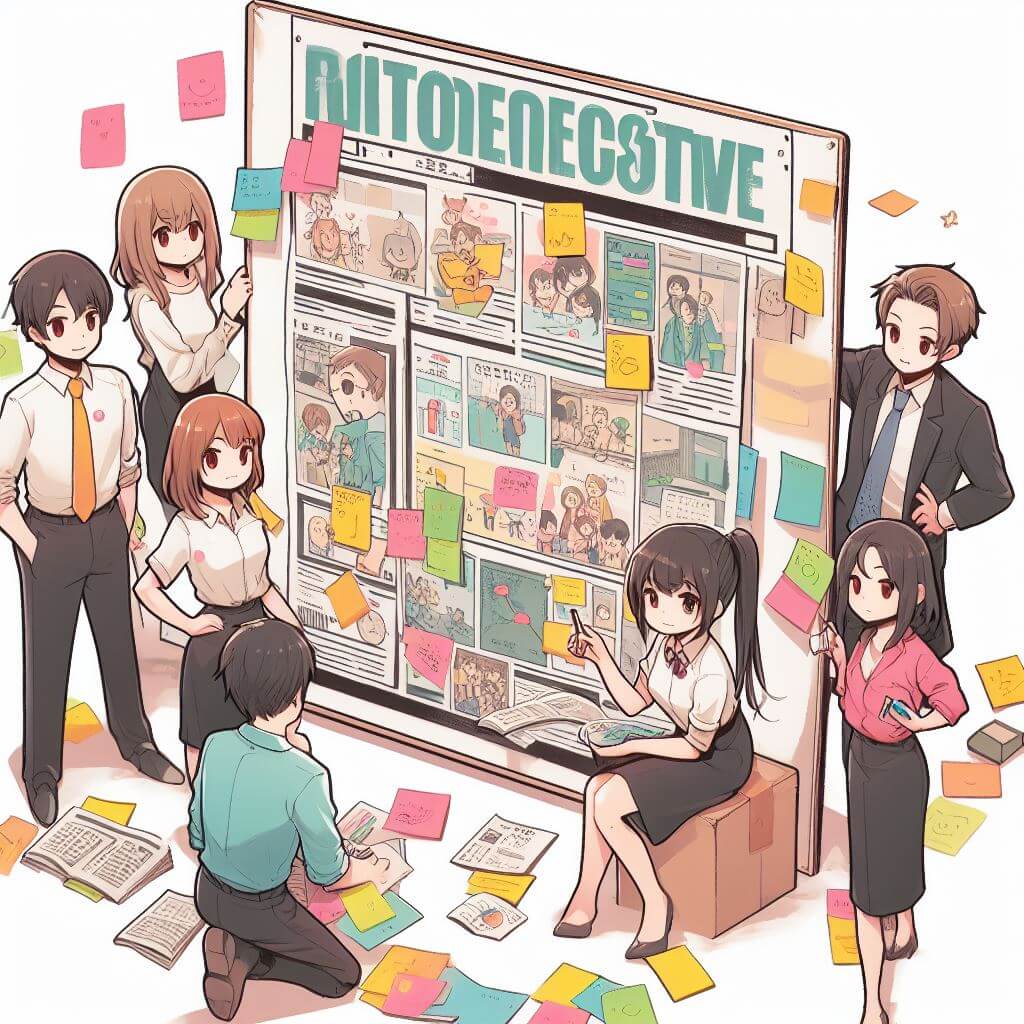Kaizen Cases and the Kaizen Mindset at KINTO Technologies
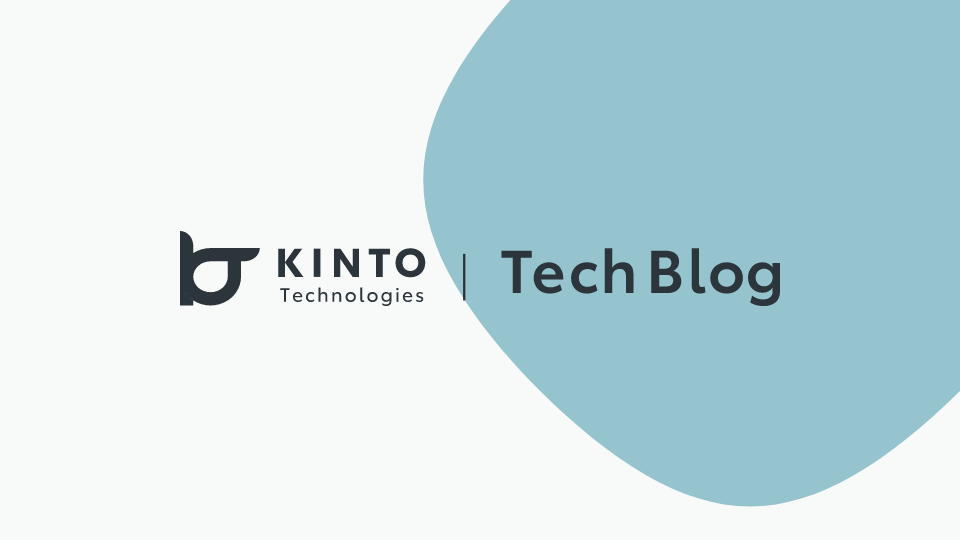
Introduction
Hello! My name is Miura and I work in the Development Support Department at KINTO Technologies, assisting the Global Development Department. My day-to-day work includes managing tools for the Global Development Division, supporting office operations to create a smoother working environment for team members, and handling various inquiries. Lately, I've been really into following my favorite band. They're only active for one year, so I've been chasing their shows wherever I can!
Now, back to the topic. Since most of my work involves a lot of detailed admin tasks, I try to find ways to make small improvements every day. In this article, I'll introduce some of the kaizen initiatives I've implemented at KINTO Technologies.
Kaizen So Far
At KINTO Technologies, being part of the Toyota Group, we often use the term kaizen rather than improvement. Here's how we define it:🔻
Kaizen refers to the practice of eliminating waste in tasks or workflows and continuously improving the way we work to focus on higher-value activities. [1]
Since joining the company, I've carried out the following kaizen activities: [1] Revising and updating mailing list management [2] Revising the logbook and approval route for lending security cards [3] Managing test devices [4] Creating name tags for shared umbrellas
Let's take a closer look at the background, actions taken, and effects.
[1] Revising and Updating Mailing List Management📧
This initiative began in my very first month after I joined the company, when I tried to call members for a meeting, but I had no idea who was on the mailing list. Although the Development Support Division where I belong, had an internal mailing list, the Global Development Division didn't have anything like that! So I thought, why not create a similar one?
But first, I had to identify which mailing lists even existed. Once I pulled the data, I was shocked! There were 94 mailing lists currently in use! Are we really using all of these? This question led me to carry out a full audit.
First, I followed the example set by the Development Support Division and created a similar list in Excel. I set up a matrix with registered members on the vertical (Y) axis, mailing lists on the horizontal (X) axis, and used a ● for registrants.
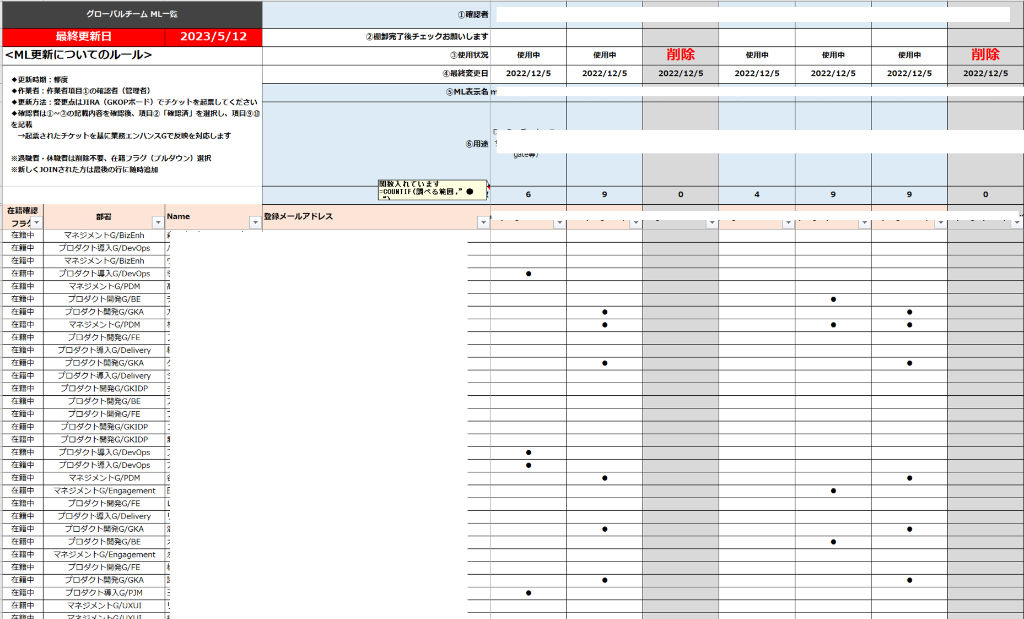
Mailing List (Excuse the heavy redactions🤣)
Each team leader reviewed the table, and I carried out an audit by confirming list administrators, clarifying the purpose of each list, and verifying registered members. To make the mailing list information accessible to everyone, I shared the table via our cloud storage, BOX. To prevent the list from becoming outdated, I set up a process where any update requests must be submitted through a JIRA ticket, and I retained sole editing rights.
Having a list makes it easy to check who was registered to which list and what types of lists existed. It also helped raise awareness across the Global Development Division that mailing lists don't update automatically. Another benefit of visualizing all the mailing lists was the ability to check for duplicates created for similar purposes. This yokoten (horizontal deployment) was possible because, although I belong to the Development Support Division, I also support the Global Development Division.
[2] Revising the Logbook and Approval Route for Lending Security Cards
At the Jinbocho Office, external vendors who come in more than twice a week are given security cards. It's a simple process, but the Excel file used for tracking didn't keep any history. So, I updated it to support change tracking and made it possible to easily identify which cards were currently unused.
By using conditional formats and functions, only available cards could be selected. This prevents the accidental deletion of user information and makes audits much easier.
 Now automatically display the number of cards and available card numbers.
Now automatically display the number of cards and available card numbers.
Regarding the change in approval route, because I belong to the Development Support Division, I couldn't submit requests for security card issuance on my own. I had to ask a member from the Global Development Division to do it on my behalf, just to follow the correct approval route. This roundabout process was not in line with the actual work, so I raised the question with the relevant division, "Shouldn't we change this odd workflow?" After that, we organized the role and system of concurrent duties of the two divisions. Now, when I submit a request, I can select either the Development Support or Global Development approval route. This change eliminated the need for others to step in on my behalf and reduced the time spent on individual coordination.✨
[3] Managing Test Devices📱
Until now, test and verification devices such as smartphones used during system development were managed in a table on Confluence. But this made it difficult to see at a glance who was using which device, and the table often went out of date. In some cases, certain devices ended up being managed informally by individuals. At one point, someone almost purchased a new device without realizing we already had one. Around the same time, I found out that company-purchased books were being centrally managed using JIRA. That got me thinking, could we manage test devices the same way?
➡️ How We Made Book Management Easier
As we transitioned to JIRA, I took the opportunity to do a full inventory check. This gave us visibility into whether anything was missing, broken, or not in use. (Some devices were even locked with unknown passwords.🔒)
Because test devices are used on a daily basis, we physically checked each one during the audit. We recorded the password settings and uploaded photos of each device to their respective JIRA tickets. This helped resolve confusion when device names alone weren't clear enough. By managing the devices in JIRA, all members can check the rental status at a glance, and by setting rental expiration dates, we can now track usage.
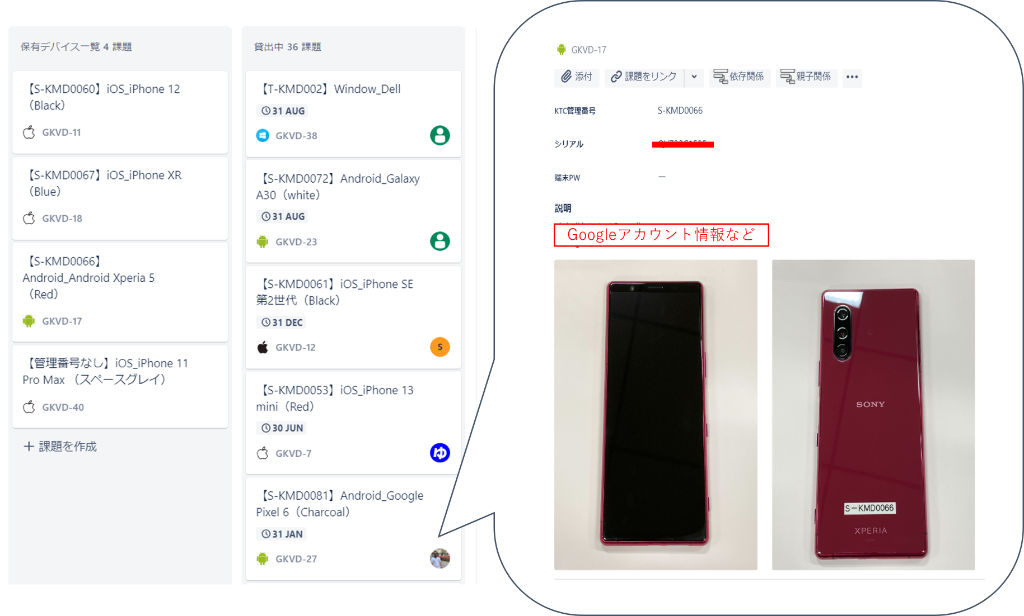 Visualization of lending conditions, detailed device information is included in the ticket.
Visualization of lending conditions, detailed device information is included in the ticket.
In addition, there is no longer the hassle of forgetting to update Confluence when borrowing or returning, or having to contact them via Slack every time.
Most importantly, by linking devices to specific users and assigning return dates, I feel that all members have become more aware that they are "borrowing" the device. I also set up JIRA to send reminders to the admin when return deadlines are approaching. Rina-san helped me implement this based on the existing book management system. Thank you so much for your support!
[4] Creating Name Tags for Shared Umbrellas☔
It all started with a request to "clean up umbrellas that have been left in the umbrella stand at the entrance." So, I checked the other umbrella stands as well. Any umbrellas that had been left for several days were announced internally and then disposed of.
One comment I received in response to that announcement mentioned the idea of making the umbrellas available to anyone for shared use by putting a plastic tape over the clean umbrellas to be disposed of and repurpose them as office loaners.
I noticed that many of the umbrellas in the office stands were clear plastic or plain designs. I figured the number of abandoned umbrellas would probably keep growing, and people might start grabbing the wrong ones by mistake. That reminded me of writing my name on some masking tape and made a name tag with a rubber band for my umbrella in the past. lol
That worked fine for me, but I thought it would be nice if everyone had a name tag if possible, so I prepared Keychains.
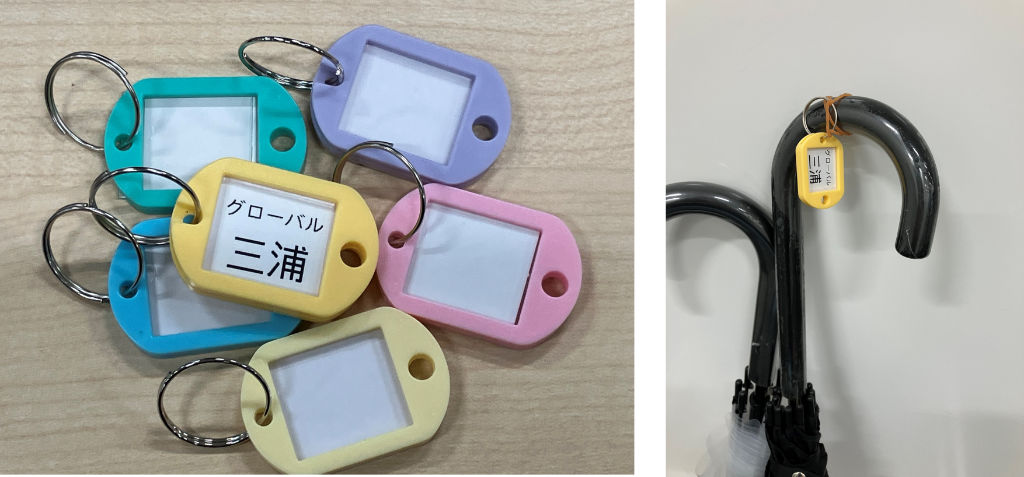 A keychain with your name on it to secure your umbrella.👍
A keychain with your name on it to secure your umbrella.👍
This kaizen is not yet widespread, but I hope it will be used more and more, not only for umbrellas, but also as name tags to be attached to personal items stored in the refrigerator.
Where Does the Kaizen Mindset Come From?
Let me share the origins of my kaizen mindset.
I've always enjoyed imagining things ever since I was a child. On my way to school, I used to often imagine things like, "Wouldn't it be cool if the road just moved on its own? ✨" or, "What if a shield popped up automatically when it rained?✨" (Kind of like something out of Doraemon, right?😅) I think kaizen is just an extension of that kind of thinking.
I believe that great people follow that imagination into careers in research or engineering, but in my case, since I'm at an average level, it's more about solving the problems right in front of me. When I find myself thinking "If only this were easier…🤔"— this is when kaizen starts.
When it comes to work, the fundamental principle is "Making work easier" means "making work enjoyable." Who wouldn't be happier if their job got just a little bit easier? Eventually, those easier ways of working become the norm.
The starting point is to make things easier for myself, but I also take the other person or people who will use it into consideration as I go along. Whenever I’m doing something repetitive or routine, I find myself thinking, "Wouldn't it be nice if this were easier?” It may be difficult to fully realize that idea by myself, but ideally, the things that have already become easier now will eventually become norms, and whoever takes over from me will go on to make them even better. I'd be thrilled if the improvements I made didn't stay as the final version, but went beyond me and continued to evolve in someone else's hands. Something like this is exciting to imagine, isn't it?
Next Kaizen - The Next Issue I Want to Tackle
Some recurring tasks are still handled in Excel, and I want to streamline them further, possibly by using macros. So, I've recently started trial and error using Sherpa[2] which was just released internally, as well as ChatGPT. With a kaizen mindset at the core, I'll continue working to make things better!✨
SherpaはSlackでChatGPTが利用できる機能です。社内エンジニアが開発してくれました!近日その記事も公開予定なのでお楽しみに! ↩︎
関連記事 | Related Posts
We are hiring!
【UI/UXデザイナー】クリエイティブ室/東京・大阪・福岡
クリエイティブGについてKINTOやトヨタが抱えている課題やサービスの状況に応じて、色々なプロジェクトが発生しそれにクリエイティブ力で応えるグループです。所属しているメンバーはそれぞれ異なる技術や経験を持っているので、クリエイティブの側面からサービスの改善案を出し、周りを巻き込みながらプロジェクトを進めています。
【PjM】KINTO開発推進G/東京
KINTO開発部 KINTO開発推進グループについて◉KINTO開発部 :58名 - KINTOバックエンドG:17名 - KINTO開発推進G:8名★ ←こちらの配属になります - KINTOフロントエンドG:19名 - KINTOプロダクトマネジメントG:5名 - KI...


![Cover Image for [生成AI][Copilot] 非エンジニアの私がAIを使って運用ツールを開発した話](/assets/blog/authors/yamayuki/01.png)
